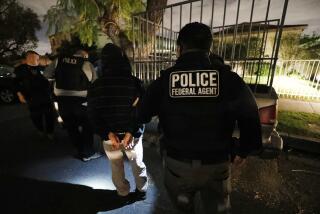Border Patrol to Test Pepper Guns
- Share via
SAN DIEGO — A workplace has its hazards. At Eric Cadena’s, it’s being pelted with rocks.
Cadena, a U.S. Border Patrol agent in San Diego, has had windows of his patrol truck shattered a few times and been struck in the knee. He has drawn his weapon more than once amid a barrage of baseball-sized rocks but has never fired.
It’s a common experience for agents who patrol the fence separating the United States and Mexico. And a potentially explosive one.
Sometimes agents are pelted by mischief-makers atop the 10-foot fence. Other times, it’s the immigrant smugglers trying to prevent officers from arresting their undocumented clients.
Agents in peril may be too far away to counter with pepper spray or baton. In those cases, the choices get narrow and brutally stark. “You back off or shoot,” said Cadena, a five-year veteran.
That may soon change, at least along seven miles in San Diego where the Border Patrol plans to conduct a yearlong test of a device that launches marble-sized capsules of powdered pepper up to 100 feet. The announcement that the agency would test 45 of the devices came Friday, part of a sweeping agreement between the United States and Mexico to make their shared border safer.
The governments emphasized how the safeguards would help undocumented immigrants, and there was praise for the pepper gun among border agents too.
Several agents interviewed during their border watch Saturday said the device will give them an alternative to drawing their side arms, which they will continue to carry. More than 60 agents have been trained to use the pepper device, which resembles an elongated pistol. Participation is voluntary.
“There’s kind of an in-between area when you can use your weapon at one extreme or your hands at another. The Pepperball launcher would be something in between,” said agent John Griffin.
Safety is a concern for agents who work this stretch east of the San Ysidro port of entry, even though patrol work these days can be tranquil to the point of being tedious. The flow of illegal immigrants here has dwindled as the U.S. government doubled the number of agents and erected two layers of fence in the past seven years.
Nonetheless, Cadena said the threat to agents from rock-throwers is worse than most people realize. “All it takes is to knock you out or hit you in the eye and you go down. The next thing you know, they come up and get your weapon, and then it just goes downhill from there,” he said.
Griffin wears a bulletproof vest on the job, though that is optional. Although he has never fired his .40-caliber pistol while on patrol for three years, Griffin said danger can arrive suddenly.
Not far from the spot where Griffin kept watch, a Border Patrol agent fatally shot an immigrant two years ago. In that incident, the agent was arresting a second immigrant when the man approached him with a rock, ignoring warnings to stop, according to the Border Patrol and San Diego police.
Still, it’s rare for agents to shoot. San Diego-based agents have fired 52 times since October 1993, nearly half during rock-throwing incidents, according to the Border Patrol. Five shootings were fatal. The agency, with about 2,000 agents in San Diego, reports three shootings since October, none deadly.
The new test has not come without resistance. Rumors that the device would eventually replace firearms prompted worry among agents, but that proved untrue. The union that represents agents argued that the government should have negotiated with employees before implementing the program.
Joseph Dassaro, president of the local representing San Diego agents, expressed concerns that agents might be left open to second-guessing by plaintiff lawyers in deadly-force cases in which the device was not employed. Griffin expressed a similar concern.
But agent John Wallace, who also is a union representative, said he is enthusiastic about the device, which he has been certified to use.
“If you can defuse a situation and keep the agent from having to shoot and kill someone,” Wallace said during a telephone interview, “then it’s served its purpose.”
More to Read
Sign up for Essential California
The most important California stories and recommendations in your inbox every morning.
You may occasionally receive promotional content from the Los Angeles Times.













